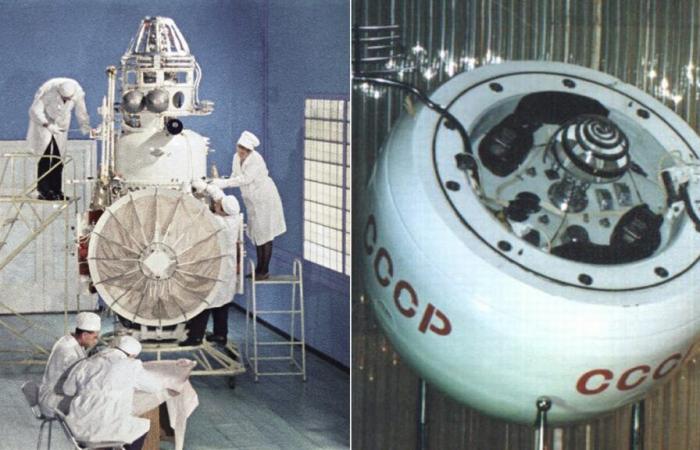In the next few days, the reentry is expected in the Earth’s atmosphere of the Soviet capsule Kosmos 482an object that has remained in orbit for more than half a century. This old ship, thrown during the golden age of Soviet space exploration, is about to make an uncontrolled re -entry, which has aroused interest and various speculations about its historical impact and meaning.
The name assigned at the time is only a generic denomination to hide its true nature. Actually, it was a probe directed towards Venus. It was launched on March 31, 1972, five days after its twin, which was called Venus —It is the name in Russian of the planet of destination – and the number 8 was assigned.
The previous one, the Venus 7He had made history. It was the first ship that managed to perch on the surface of Venus and transmit information from there. All previous attempts had failed: the thick atmosphere of the planet delayed its parachute fall for more than an hour and, in all that time, the huge pressures and temperatures destroyed the probes before reaching the ground. The landing of the Venus 7 It was very rugged.
When touching the Venusian surface, the capsule was tilted and its antenna lost the direct link to the Earth. Only after several days of analyzing the wemph signal, the Russian engineers managed to extract just under half an hour of information that confirmed the infernal conditions that occur in Venus: 475 ° C and more than 90 atmospheres of pressure. The equivalent on Earth would be to be a kilometer below sea level and, in addition, with sufficient heat to melt the lead.
As a precautionary measure, during those first years of planetary exploration, both Russians and Americans used to send at least two equal ships, hoping that the failure of a mission would not compromise. The Venus 8 He succeeded, but his twin no. His rocket placed it in orbit around the Earth, as planned, but the ignition of the last stage, which should put it in an escape trajectory to Venus, only lasted a couple of minutes, half of the necessary.
The probe was trapped in an elliptical terrestrial orbit, with an apogee to more than 9,000 kilometers high, but a very low perigee. Continuing with his policy of not baptizing the probes until they were on their way with all their systems in order, after the ruling the Soviet Union left him his preliminary name Kosmos 482. Last month, Russia launched its 2583 spatial object, which is unqualified, but seems linked to the development of antisatellite weapons.
In June 1972, just three months after the launch, the capsule of the Kosmos 482 He separated from his carrier ship. That was approximately the time it was calculated that it would take to reach Venus, so it was thought that an internal timer gave the order to release it, believing that he was approaching his destiny. Subsequently, declassified documents have shown that it was an intentional decision. That maneuver left two separate vehicles in almost the same orbit.
Due to the slight friction with the highest layers of the atmosphere, during the passage through perigee in each orbit, the altitude of both vehicles was descending. The main nave, much more fragile than the capsule, was destroyed nine years later. The capsule itself, more compact and with a spherical form less susceptible to atmospheric friction, has continued in orbit so far. More than half a century.
Lately, tracking equipment has determined that capsule perigee was just over 150 kilometers. It is impossible to maintain that level much more, so its fall is imminent. The specialist Marco Langbroek, from the Technical University of Delft (Netherlands), estimates that it will do so on May 10.
What will fall on earth? Essentially, the capsule that should be posed in Venus. A sphere of almost 500 kilos. It is repaired to resist brutal temperatures and pressures, much higher than those recorded on Earth. The previous models, which did arrive in Venus, endured senses of 300 g without fragment.
Through telescopes and video cameras, recent vehicle photographs have been obtained. Although very blurred, they show an elongated, not very spherical shape. It is possible that the parachute had been deployed many years ago (also obeying orders from the internal sequencer). In any case, it will not make any difference. The capsule will behave like a meteorite. It may be broken into pieces or – the most likely – that survives in one piece. In that last case, and if it falls on the mainland and someone finds it, it will be an exceptional museum piece, witness of a technology already overcome.
After stopping in the atmosphere, the ground will reach about 250 kilometers per hour. With its weight, the energy of the impact will be equivalent to detonating a quarter of a kilo of dynamite, which could certainly cause serious damage, although very localized.
Until shortly before the reentry it is impossible to predict the point of fall with some accuracy. It can be anywhere on the planet between latitudes 53 north and 53 south. That includes a good part of Europe, Asia and America and almost all of Africa, in addition to an enormous oceanic extension. The probabilities, then, are inclined to go to the sea or desert areas. After all, in our day to day nobody worries that a meteorite can fall on him; So this threat should take our sleep away.






